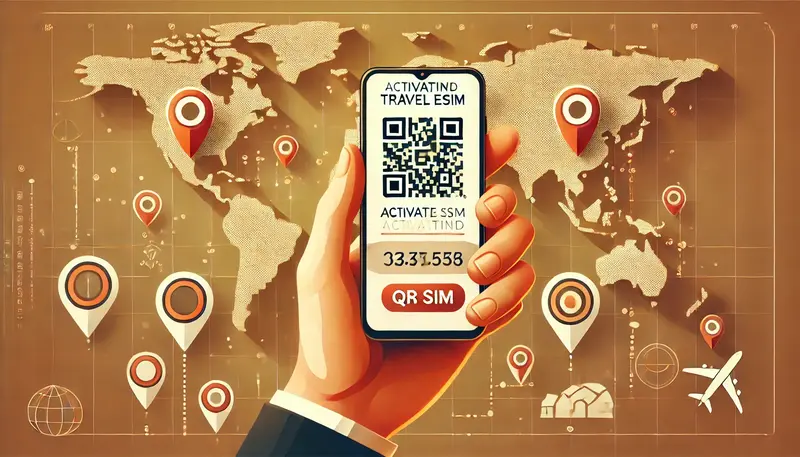I once spent two hours in a Tokyo train station trying to find a SIM card shop, only to realise my phone didn’t even take physical SIMs anymore. I ended up using café Wi-Fi and Google Translate to get myself back to the hostel. That was the moment I realised: it’s time to go full eSIM.
If you’ve ever wondered whether eSIM or physical SIM is better for travel, you’re not alone. With so many options these days - from buying local SIMs at airports to downloading travel eSIMs in minutes - it can get confusing fast. In this guide, I’ll break down the real-world differences between physical SIMs and eSIMs, highlight the pros and cons of eSIMs, show you which phones support them, and help you decide what’s best for your next trip.
What’s the Difference Between an eSIM and a Physical SIM?
Let’s start with the basics. If you’ve ever swapped out a tiny piece of plastic in your phone while squinting in an airport lounge, congrats - you’ve used a physical SIM. These little cards have powered our phones for decades. But now there’s a new kid on the block: the eSIM. And no, it’s not some mysterious tech reserved for spy gear or electric cars.
Both options connect you to mobile networks when travelling, but they do it in pretty different ways. If you’re curious about the deeper tech side of things, I’ve written a full explainer over on our WTF is eSIM? page. For now, let’s break it down in simple terms.

What is an eSIM and how does it work?
An eSIM is short for "embedded SIM" - and yep, it’s built right into your phone. No fiddling with trays, no tiny tools, no risk of losing a microscopic card in the seat pocket of row 42B. Instead of popping in a plastic SIM, you just download a mobile plan online. You can usually scan a QR code or click a magic link, and boom - you’re ready to go.
I love eSIMs for travel because they’re fast to install (literally takes minutes), and you can activate them the moment your plane hits the tarmac. At ZenSim, we even let you add multiple countries to the same eSIM profile, so you’re not juggling a new plan every time you cross a border. It’s honestly made my travel setup about 90% less chaotic.
eSIMs work on most newer phones, and they’re becoming more common with each new model (see our eSIM compatibility checker. As someone who travels often and hates faffing around in airport kiosks, I’m fully on board.
What is a physical SIM and how does it work?
The trusty physical SIM - it’s been around for ages, and it still gets the job done. A physical SIM is a small chip you insert into your phone to connect to a mobile network. You’ve probably used one every time you’ve swapped your Aussie SIM for a local one in Bali or Europe.
Travelling with a physical SIM usually means hunting one down at your destination. That can be part of the fun if you enjoy the local telco adventure - I’ve definitely had my fair share of weird mall kiosks and “cash only” signs. But it also means you need to physically swap out your main SIM, which can be annoying. Not to mention when bying an eSIM online you can compare pricing which can be hard when shopping in physical stores or kiosks.
They’re still widely used and compatible with pretty much every phone. But compared to the instant setup and flexibility of an eSIM, they’re starting to feel a bit�… analog. Still, if you’re staying in one country for a while and you find a good local deal, they can be worth it.
eSIM vs Physical SIM for Travel: A Side-by-Side Comparison
When it comes to eSIM vs physical SIM travel, there’s no one-size-fits-all answer. But there are some very clear pros and cons depending on how you like to travel. Here’s a quick side-by-side breakdown before we dive into the juicy details.
- Setup: eSIMs can be downloaded and activated in minutes. Physical SIMs require a trip to a store or kiosk.
- Coverage: Both types connect to the same mobile networks, depending on your provider.
- Cost: Physical SIMs can be cheaper locally, but eSIMs let you compare and buy plans online with no surprises.
- Multi-country travel: eSIMs let you switch countries with a tap. Physical SIMs mean more swapping (and more plastic).
Let’s take a closer look at each of these in real travel situations.
Setup and Activation While Travelling
This one’s a game-changer. With a travel eSIM, I can choose a plan from my laptop or phone, scan a QR code, and be ready to go before I’ve even packed my bag. You can compare pricing online across countries, providers, and data amounts without ever stepping into a store. And when you land? It’s already working.
Physical SIMs, on the other hand, usually mean finding a shop at the airport or in town, showing your passport, waiting in line, and hoping the staff speak your language. It’s not awful, but it adds friction - especially if you’re arriving late, tired, or jetlagged. I’ve been stuck more than once without data trying to load Google Maps just to find the store that sells SIMs.
Coverage and Compatibility
Here’s the thing most people don’t realise: whether you’re using an eSIM or a physical SIM, you’re usually connecting to the same local networks. The real difference comes down to which provider you buy from.
At ZenSim, we partner with solid networks and test coverage before we sell a plan, but not every company does that. If you’re comparing options, don’t just look at price - scroll the reviews. That’s the fastest way to find out if a provider uses decent networks in the countries you’re visiting. Compatibility is also key. Make sure your phone supports eSIMs, especially if it’s an older model or from certain regions (see our eSIM compatibility checker.
Cost and Data Options for Travellers
Travel eSIMs tend to be more transparent. You can see the pricing upfront, there’s no sneaky charges, and many providers offer plans that cover multiple countries - which always ends up cheaper than buying a new SIM in each place. I’ve seen great prepaid plans for as little as $4 for a few days, and bigger data bundles that cost way less than international roaming.
Switching Between Countries or Carriers
This is where eSIMs win, hands down. If I’m going from Italy to Germany to Croatia, I can line up my plans in advance and switch them over with a tap in my phone settings. Some eSIMs even let you add countries to your existing plan, so you don’t need to install anything new.
With a physical SIM, you’ll be juggling tiny plastic cards, trying to remember which one goes with which country, and hoping you don’t drop one down a hostel bunk bed crack. Unless you love SIM swap theatre, going digital makes life a lot simpler.

Pros and Cons of Using an eSIM for Travel
If you’ve been wondering whether to go with an eSIM or physical SIM for travel, here’s my take: eSIMs are the future. In fact, the latest iPhone released in the US doesn’t even come with a physical SIM slot anymore. That’s a pretty loud signal about where things are headed.
Still, no tech is perfect (yet), so let’s break down the real-world pros and cons of using a travel eSIM when you're hopping between countries.
Pros of Travel eSIMs
Let’s start with the good stuff - and there’s a lot of it. The biggest win for me is no more fumbling around with tiny bits of plastic. With eSIMs, everything happens digitally. You can buy online, install in minutes, and activate your plan the moment you land. There’s no queue, no passport check, and no sales pitch from a bored kiosk guy.
You can also store multiple eSIM profiles on your phone if necessary say for work & travel. A huge bonus is at ZenSim you can add multiple countries (or regions) to the same eSIM. So, for example if you’re flying to Europe but stopping in Singapore on the way, you can add a Singapore top up to your Europe eSIM and you’ll be covered everywhere you go!
And honestly, I just like being able to compare prices and data plans from my couch instead of hunting down random telco shops in unfamiliar cities.
Cons of Travel eSIMs
eSIMs are brilliant - but they’re not perfect. The biggest hurdle is compatibility. Most modern phones support eSIMs, but not all. If you’re using an older model or a phone from certain markets, you might need to double-check if it works with eSIM before you buy. Some phones are also provider locked (particularly phones purchased in the US).
Another thing to be aware of is top-ups. Some eSIM providers make it super easy to recharge or extend your plan - others, not so much. With ZenSim we’ve worked hard to keep the process smooth, but there are still providers out there where topping up means starting all over again.
That said, the cons are shrinking fast. More phones support eSIMs every year, and the experience is getting better with every update. If you're into convenience, flexibility, and skipping the SIM swap hassle, eSIMs are absolutely the way forward.
Which Phones Support eSIM for Travel?
Before you get too excited about ditching physical SIMs forever, let’s make sure your phone is ready for the eSIM life. While most new phones do support eSIM these days, not every device is on board yet. And trust me, the last thing you want is to buy a travel eSIM and realise your phone can’t use it.
The good news? If your phone was released in the last four or so years, there’s a good chance it’s eSIM-compatible. Still, it’s worth double-checking before you make any plans.
Popular eSIM-Compatible Phones in 2025
Here’s a quick rundown of the most popular phones that support eSIM in 2025:
- iPhone XR and newer
- Google Pixel 3 and up
- Samsung Galaxy S20 and newer (including Z Flip and Fold series)
- Many Huawei, Motorola, and Oppo models
- Newer iPads and Apple Watches
And if you’re rocking the latest iPhone from the US? It doesn’t even have a physical SIM slot anymore - it’s eSIM or nothing. That’s how confident Apple is in where this tech is going.
Now it’s important to keep in mind there are exceptions, some phones purchased in the US are carrier locked (don’t ask me why) and some phones which are imported from China and made for the China market may also not support eSIM.
Not to worry! If you purchase an eSIM from ZenSim and your phone is not compatible we’re always happy to offer you a full refund – it’s the Zen way.
If you’re not sure whether your phone is compatible, we’ve made it easy. Just head over to our eSIM compatibility checker and get a quick answer.
Final thoughts
So, is eSIM or physical SIM better for travel? If your phone supports it, eSIMs are hands-down the easiest, fastest, and most flexible way to stay connected while abroad. No plastic, no queues, just instant data wherever you land. Still unsure or need help picking the right plan? Feel free to reach out - we’re happy to help you get sorted before takeoff. Safe travels!

Written by Andy Linton
Co-founder of ZenSim, loves a bit of Star Wars.
Andy has been in the telecommunications industry for the better part of 20 years. Somewhat of a super-nerd, Andy is the co-founder of ZenSim and the maestro behind the systems we use to provide our services.
Let's connect on LinkedIn 👉
Get amongst it
Join the community
We will reach out when we launch new products, about our sustainability projects, specials, new innovations or maybe even cool sh*t we think is inbox worthy.












